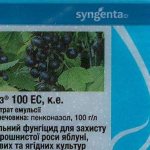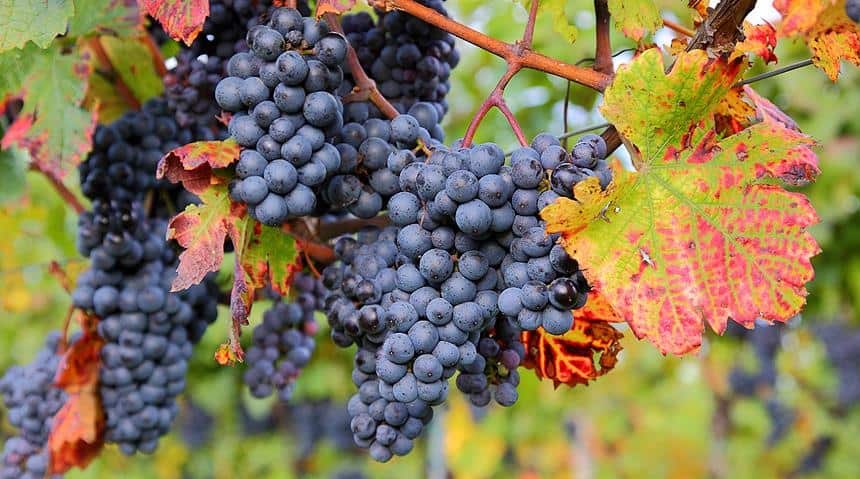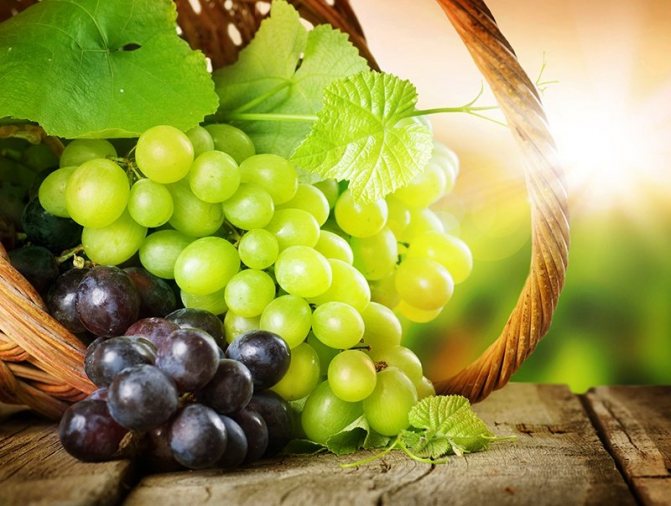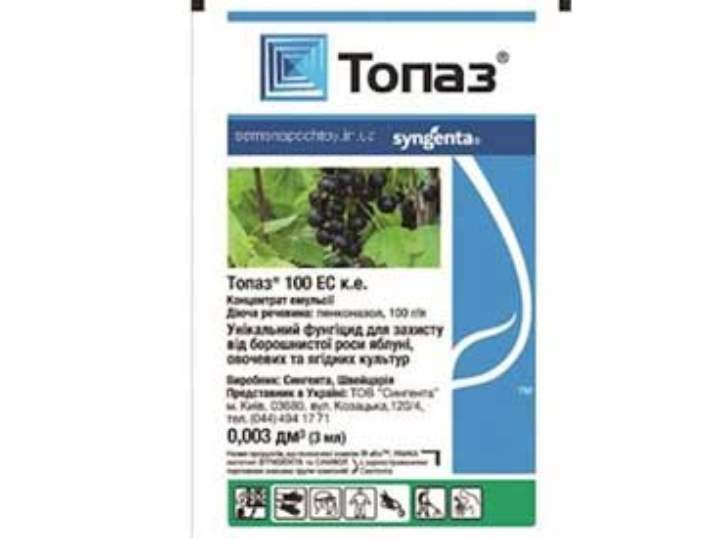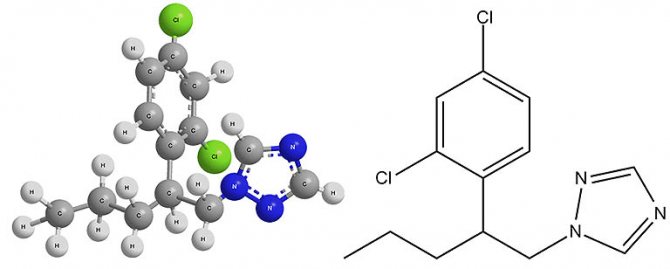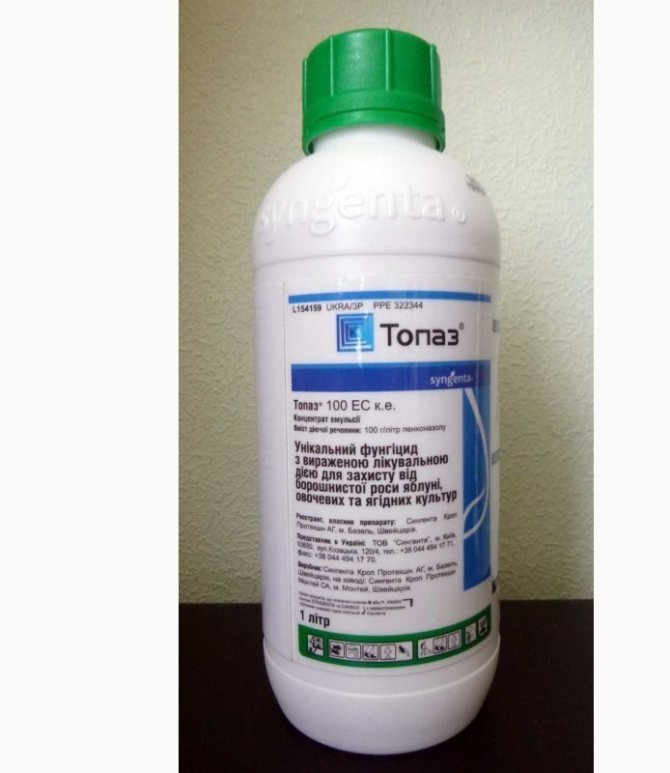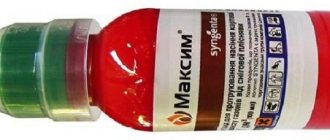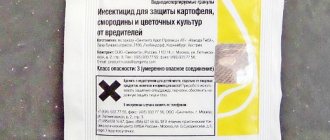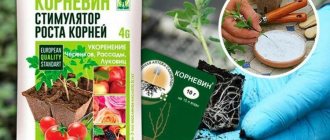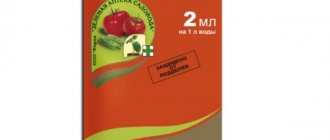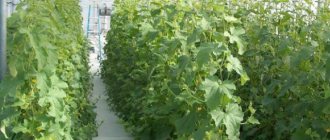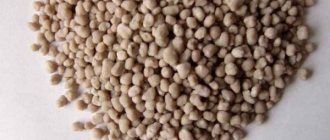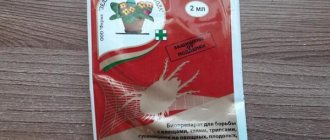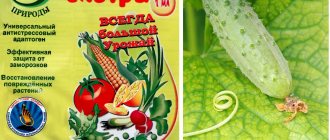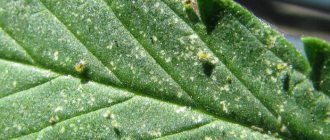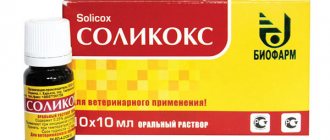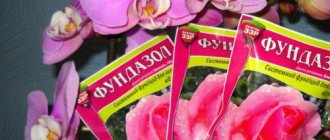Gardeners who grow grapes have probably faced such a serious problem as fungal diseases. Of course, there are many "folk" remedies for the treatment of such ailments, but if you want to quickly and effectively get rid of the infection, then fungicides are used. One of these means is the drug "Topaz", which we will talk about in this article.
- 1 Description and mechanism of action
- 2 Instructions for use
- 3 Precautions
- 4 Pros and cons
- 5 Video "Spraying the vineyard"
Instructions for use
Plants are processed both when the first signs of fungal infection appear, and as a prophylaxis (at any stage of growth, preferably at the beginning of the season).
You can apply the fungicide according to the standard scheme:
- Wear gloves.
- Open the ampoule and dilute it first in a small volume of water.
- Mix thoroughly and pour into a 10 liter bucket.
- Continue stirring for another 1-2 minutes.
- Pour into a spray bottle and spray on foliage and stems.
- After the first treatment, carry out the second after 10-15 days.
The dosage, the number of treatments per season depends on the specific crop. In the case of fruit trees, you can focus on the consumption: 10 liters of solution per 1 adult bush (cherry, currant) or 20 liters of solution per 1 adult tree (for example, an apple tree).
| Culture | Consumption of the preparation, ml / 10 l. | Working solution consumption | Number of treatments |
| Cucumbers | 2 | 10 l / 100 m2 | 2 |
| Apple tree | 4 | 4 | |
| Currant | 2 | 4 | |
| Cherry | 2 | 2 | |
| Raspberries | 4 | 2 | |
| Strawberry | 2 | 2 | |
| Peach | 4 | 4 | |
| Grapes | 4 | 4 | |
| Flower plants | 4 | 1 | |
| rose flower | 4 | 3 | |
| Carnation | 4 | 3 |
* 1 ampoule contains 2 ml, so 1 or 2 ampoules are enough for 10 liters.
Expert opinion
Samoilov Vladimir Alekseevich
Experienced gardener and a great specialist in gardening technology
Ask a Question
Best used in dry and calm weather. It is advisable to spray the plants at sunset so that the sun's rays do not burn the foliage. Optimally, if, according to the forecast, precipitation is not expected in the next 3-4 days
Release form and composition
The fungicidal preparation is produced by 2 companies - Avgust and Syngenta. This is a concentrated emulsion (e), packaged in ampoules of only 2 and 10 ml (Avgust) and in 1 liter bottles, 5 liter canisters (Syngenta).
The active substance of Topaz is penconazole, it is in the emulsion 100 g per 1 liter. It is quickly absorbed by the tissues of the treated plant, spreads to all its parts, thereby protecting not only foliage and stems, but also young shoots, even under adverse weather conditions.
Safety measures during processing

Use protective equipment when working with Topaz!
Despite the fact that the drug is not very dangerous for both humans and insects, as well as animals, the treatment should be carried out taking into account the safety rules:
- All strangers, children, and pets must be removed from the site.
- A mask, glasses and gloves must be worn. It is also advisable to wear a raincoat or disposable gown.
- No food, drink or smoking is allowed during spraying. Don't be distracted by conversations.
- If the drug gets on an open area of the skin, it must be washed immediately with water and soap.
- In case of contact with eyes, treat with water jet as soon as possible (under low pressure).
- If the solution accidentally gets inside, you need to take 5-7 tablets of activated carbon and wash them down with water.
If any other symptoms occur, stop working immediately and consult a doctor.
If there is an apiary nearby, bee years can be started after 3-4 days.
How to use it correctly?
The waiting time for Topaz to dissolve in water at room temperature is limited by the time of thorough mixing. Spraying the bushes is carried out in conjunction with the treatment of a soil area within the radius of the plant's root system, which is also a preventive measure against fungal spores that overwintered near the cultivated plant.
The first treatment is carried out before the buds open, the leaves appear. In the spring, the disease of the vine cannot be determined until the leaves have bloomed. Preventing fungal contamination of the seedling is always easier than treating the plant. The disease takes away the strength of the plant, which affects the taste of the grapes, the size of the harvest.
Attention! The processing of plants from 1 are of land takes from 1.5 to 2 liters of the dissolved agent, which depends on the height of the cultivated crops.
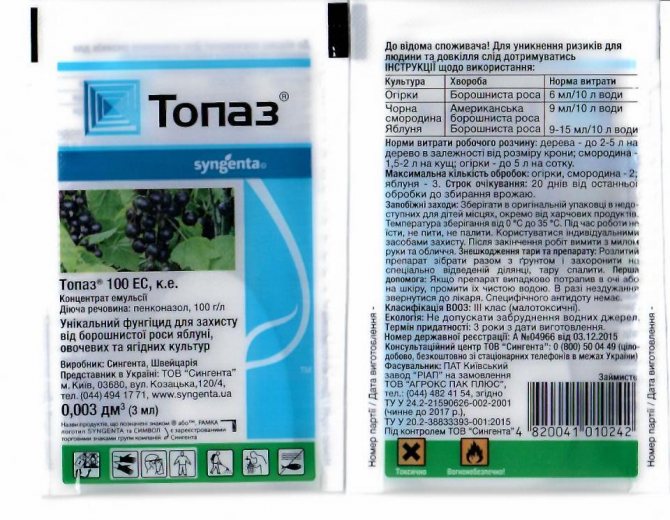

If the disease could not be prevented at an early stage, then the next treatment should be carried out 10 days after the first. Further, prophylactic antifungal sprays of all parts of the bush are carried out every decade, while the instructions indicate only 2 mandatory treatments - in spring (before the flowering of the bush) and in autumn (after harvesting, pruning the bush and falling foliage).
Despite the fact that the tool is not susceptible to loss of its properties during temperature extremes, a sharp cold snap, it makes no sense to use it for winter treatment of bushes.
For dormant mycelium, "Topaz" is safe, because the growth of fungal spores will begin only when warm days come, and the period of action of the antifungal agent will end in 2 weeks. The recommended number of spraying of fruit trees per season is no more than 4 times. When a plant is damaged, in order to save it, a larger number of treatments are allowed.
Analogues of "Topaz"
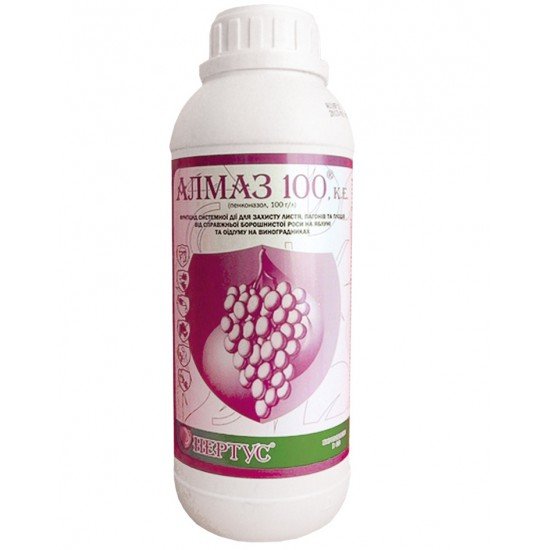

Analogues of "Topaz" include 2 fungicides that have the same active ingredient in the composition (penconazole, 100 g / l):
- "Diamond".
- Avarta.
"Almaz" is produced by Hungarian. This drug is used primarily to protect apple and grapes from the same fungal diseases. Fungicide "Avarta" is used in a similar way, although in Russia it is not so widespread.
Description
Grapes, being a delicate fruit crop, require special attention and quality care. Often, grape bushes infect various fungal diseases, as a result of which the fruits become smaller, lose their presentation and taste, yield decreases, the plant stops growing and developing. If you do not take emergency measures during the period of infection, then you can lose the entire garden.
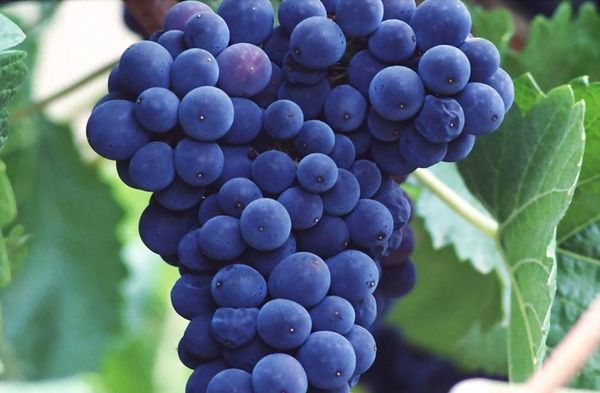

Many gardeners prefer the traditional methods of fighting fungal infections that have been proven over the years. However, it is not always possible to get rid of one or another ailment that has struck the grape bushes with the help of ordinary folk remedies. More effective, as noted by experts in the field of viticulture, are fungicidal preparations. Today, specialized stores offer a wide range of fungicides. How to choose the best drug, you ask. Among the huge amount of fungicides, the drug "Topaz" is in great demand among modern gardeners, which has shown good results in the fight against many fungal diseases (powdery mildew, rust, fruit rot, etc.). The main active ingredient is penconazole, which belongs to chemicals of the third level of danger to humans and animals.
When treating a vineyard with this drug, you do not have to worry that the plants will stop growing and stop developing, as often happens when in contact with stronger chemists. The peculiarity of the Topaz fungicide is that under the influence of penconazole the spread of the fungus is suppressed and the protective function of plants is developed. This drug has a powerful effect on the causative agents of fungal diseases. Suitable for spraying vineyards even in rainy and windy weather.
Compatibility with other products
Topaz can be used with almost any other drug. Usually, for prophylaxis, treatment with only this remedy is enough.
For a complex effect (especially when the first signs of infection appear), it can be used together with other fungicides:
"Horus" - Helps to cope with coccomycosis, alternaria and clotterosporia.
"Topsin-M" - For the treatment of gray rot, scab, anthracosis.
"Cuprosat" - Treats late blight and cerosporosis.
These preparations contain other active ingredients, due to which they combine well with Topaz.
Systemic fungicides for the treatment of grapes
The mechanism of action of systemic fungicides is the penetration of the active substance into the affected culture, spreading through the juice and affecting the fungus "from the inside". This is a stronger drug. It is used for already infected grape plants.
Systemic fungicides are capable of destroying the mycelium, suppressing its reproduction. Before starting an active action,
the fungicide must be absorbed into the plant. This takes 2 to 6 hours.
From the moment of spraying, the grapes act for 21 days. The active ingredient spreads evenly over all stems, reaching the roots. 6 hours after treatment, any bad weather (rain, increased humidity, high temperature) is not dangerous.
Photo of systemic fungicides
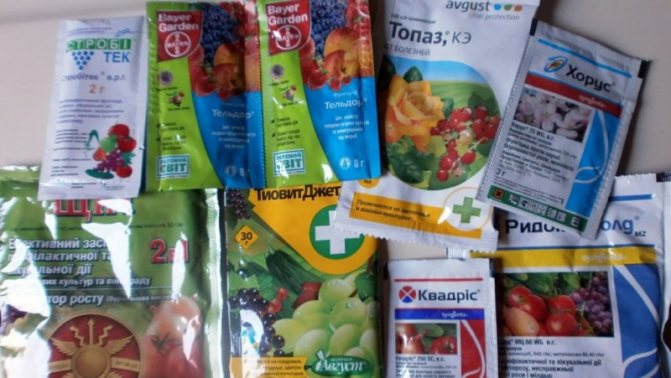

The only significant drawback
—
the ability of the fungus to adapt over time to such funds.
Systemic fungicides for grapes: Quadris, Strobi, Skor, Topaz, Falcon, Folpan.
Advantages and disadvantages
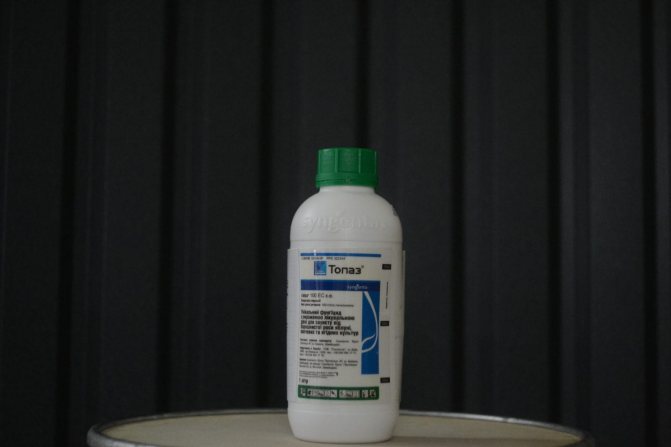

Fungicide "Topaz" has shown its high efficiency both when used in private households, and in the case of application on an industrial scale (including in aerial processing).
This is a systemic drug that quickly destroys diseases and provides reliable prevention of the development of fungal infections.
Its main advantages include the following:
- Can be used at any stage of growth - both at the beginning and at the end of the season.
- Protects various crops - berries, shrubs, fruit trees, flowers, cucumbers.
- Due to the long-term exposure, in most cases 2 treatments are sufficient with an interval of 2 weeks.
- Since the active substance enters the plant tissue very quickly, the risk of being washed away by rain is reduced.
- The drug does not leave a trace on the fruit, which is what many other fungicides and pesticides in general suffer from.
- The active ingredient is absolutely safe for plants (not phytotoxic).
- The fungicide is of little danger to both humans and beneficial insects.
- Processing is easy in any conditions.
- The consumption of funds is small - only 1-2 ampoules per bucket, which is enough for 1 hundred square meters or 1 bush.
- The cost is also small - 30 rubles for 1 ampoule. For a standard garden for 1 season, you can purchase 20-30 ampoules, which will cost no more than 1000 rubles.
However, this drug also has some disadvantages:
- It is only safe at the indicated dosage. If exceeded, it can lead to the death of the plant.
- The agent can accumulate in the soil, so you should not treat plants in the same area for 3 or more years in a row.
- It is a one-component solution that has no additional effect (eg growth stimulant, fertilizer). However, almost all other fungicides have a similar disadvantage, so it can be attributed to the disadvantages only conditionally.
Mechanism of action
Penconazole inhibits fungal spores, stopping the reproduction and spread of diseases. The effect of Topaz is possible even at a temperature of 10 ° C, it can be used even when it is raining lightly (due to its rapid absorption into plant tissues). The drug begins to act within 0.5 hours after treatment, stops the growth of the fungus in 2-3 hours. The time of the protective effect of Topaz is 1.5-2 weeks.
The timing of treatment with this fungicide is at the beginning of the season for preventive purposes (to suppress a possible primary infection and prevent spread to healthy plants) and when the initial signs of the disease are detected.
Should I use Topaz fungicide: gardeners reviews
Do you consider Topaz fungicide an effective remedy?
Of course! Not really
According to various Internet portals, "Topaz" is actively used by many gardeners, and the tool regularly receives high ratings from users (4.4-4.5 points out of 5).
A year ago, she began to actively grow violets, they grew quickly and confidently, pleasing to the eye. But in the middle of summer, some kind of dust appeared on the leaves. At first, I didn't think about the fungus at all, but it turned out to be powdery mildew, as they later suggested on the forum. I bought the first available product. Fortunately for me, it turned out to be Topaz. This is an excellent drug that costs a penny, but it helps for the entire season. I carried out one treatment and the second after a couple of weeks - the dust disappeared completely. And even this season I didn't hit the plant anymore - I haven't processed it yet, but I have already prepared several ampoules.
Pirogova Lyudmila Vladimirovna
44 years old, Kaluga
When our currants were covered with powdery mildew, a neighbor came and said to dig it up and burn it. I nevertheless decided to try to process it with something. I read several reviews and bought Topaz: it is inexpensive, at 28 rubles per ampoule. I processed it a couple of times in the month of July, used up a bucket per bush, generously not sparing it. The effect did not come immediately, but only after 2 years. Of course, during this time, many would have thrown out the currants, but it's not so easy to plant new bushes. So I definitely recommend it, especially for such a penny!
Antokhina Ekaterina Alexandrovna
67 years old, Krasnodar
Topaz is quite a decent remedy, our domestic fungicide. I use it only for prophylaxis, purely according to the instructions. The neighbors periodically have rust on the cucumbers, but I did not have this at all. That's all I can say.
Belozerov Alexander Yurievich
63 years old, Izhevsk
I decided to take a chance and grow a capricious rose Avolanche - whoever came across such a thing will understand. I did everything right, and suddenly - dust on the leaves means powdery mildew. I used to fight with folk methods, but a friend advised Topaz. I processed it like this: 1 ampoule for 5 liters of water, 2 times with an interval of 10 days. Gradually, the rose began to recover - it is true, the old branches bent, but new shoots started. I'm waiting for the result
Lazurskaya Antonina Stepanovna
51 years old, Korolev
I attacked the Topaz fungicide by accident. Just 5 years ago, rust settled on the gooseberry, and urgent measures had to be taken, folk remedies no longer helped. Topaz somehow immediately came to my liking, it helped very well in its time. And we also tried other means, but for some reason they do not give an effect. Perhaps the plants are already accustomed to a certain regime, so I am not planning to change anything yet.
Vinnik Petr Semyonovich
43 years old, Samara
Fungicide "Topaz" has a number of tangible benefits. This is a fairly effective tool that can be used alone or in mixtures with other drugs.Treatment is best done at the beginning of the season for prevention. During spraying, mandatory safety measures should be observed, especially for persons with respiratory and cardiovascular diseases.
The best fungicides in the fight against grape diseases: description, action, application
To say that one drug is better than another is definitely impossible. Each substance has a targeted effect on a certain type of fungus, infection and other pathogens. Winegrowers with little experience use complex preparations more often. It is difficult for them to identify the disease immediately. Experienced growers can accurately determine what affects the crop and choose the most suitable and gentle fungicide for treating grapes from diseases.
The best remedies against grape diseases - video
Features for use
The maximum effect as a therapeutic, prophylactic agent Topaz (indicated in the instructions) should not only be diluted correctly. But also remember that the treatment of diseases has nuances. It is worth adding that not all vegetable crops require a strong solution. When starting to use Topaz, take into account these points.
Prevention of grape bushes, cucumbers and currants is carried out with a working solution: 5 l + 1 ampoule (1 ml). Re-processing is carried out depending on the disease and condition of the plant.
Vegetables
Powdery mildew topaz is used most often. The fungus makes its way annually to 75% of summer cottages. But it passes the place where the gardener carries out regular disinfection. The chemical is fast acting. If it starts raining after the treatment, no re-treatment is required. Work continues on schedule.
Fungicidal processing of vegetable crops is carried out up to 4 times during the season. This is enough so that no problems appear on the leaves of plants.
Fruit trees
Prevention of powdery mildew is also necessary for trees. Therefore, the application of the working solution should take place throughout the garden, vegetable garden. The disease is often found on apples, pears, and cherries. Fruit rot is also a common phenomenon (mummification of the fruit, the green part of the tree, occurs).
To protect fruit trees, shrubs, an ampoule of fungicide is diluted with 5 liters of water. Processing takes place with a spray gun. For one adult tree, the dosage is 5 liters, for young growth - up to 2 liters. With preventive treatment, application is permissible strictly according to the instructions - 4 times per season.
Preparation of "Topaz" working solution
It is very easy to prepare a working fluid from an emulsion concentrate. The main thing is to stir the drug well in water, remembering that it does not dissolve, but a dispersed system is formed.
To prepare "Topaz" for work, non-chlorinated water at room temperature is required. According to the instructions, the required amount of the drug is measured and poured into the water. After that, within 3-5 minutes, the liquid is vigorously shaken or stirred.
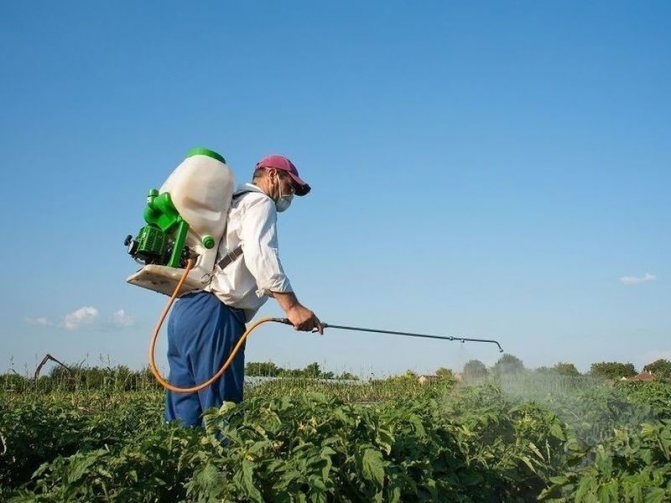

The fungicide solution is prepared in a separate container. The ampoule is opened immediately before use. The required amount is diluted according to the instructions for use, depending on the culture and the recommended dosages.
Observance of precautions
Only by observing all precautions can you save and protect crops from diseases, without polluting the environment and without harming your own health.
- During the dilution of the drug, only household utensils are used, but not food.
- Before processing, children, pets are retracted to a respectful distance.
- All personal protective equipment should be worn - tight overalls, rubber gloves, glasses, mask.
- Do not smoke, eat or drink while processing.
- After completing the work, you need to wash your face and hands with soap, and rinse your mouth thoroughly.
- Store the chemical in a dark place out of the reach of children, away from food, medicine and fire. The optimum storage temperature is from ten to thirty degrees Celsius.
- If a biological product gets on the skin or organs of vision, you should immediately wash yourself with plenty of warm water.
- If the agent has entered the human body, the best safety measures are to drink a few glasses of activated carbon water.
For many years, a slightly toxic, preventive and therapeutic drug has occupied a leading position in the chemical industry, being an indispensable assistant for gardeners and gardeners. When using a fungicide, Topaz, in the garden, the instructions for use should always be at hand and protect the user from wrong actions.
What fungicides to use for specific grape diseases
If the grapes are infected with mildew, then you should use products containing copper, such as Bordeaux liquid.
In the fight against mildew, you should apply:
- Carbio Top;
- Ridomil Gold.
The fight against powdery mildew seems to be a complex task and involves a number of therapeutic and preventive measures. Fungicide treatment of grapes also plays an important role in the fight against powdery mildew.
There are chemicals that help fight mildew and grape powder at the same time:
- Strobe;
- Vectra;
- Falcon;
- Alto Super Topaz;
- Fundazol.
If the vineyard is affected by gray rot, then you can treat it with fungicides:
- Topsin;
- Ronilan;
- Rovlan;
- Euparen;
- Sumileks.
From white and black rot of grapes, you can use the following means:
- Topaz;
- Captan;
- Baytan;
- Tsinebom;
- Flaton;
- Bayleton.
Important!
Before use, carefully read the instructions for use of fungicides for grapes.
Fungicide "Cabrio top" for grapes
Cabrio Top eliminates even massive outbreaks of powdery mildew. Excellent fight against anthracnose, mycosis. The substance works for a month. No bad weather affects its action.
Cabrio Topom is used during the flowering period of the crop, before the appearance of the bunches. Creates protection around the plant for up to 2 weeks. If we take the average value - from 10 to 14 days.
The result of processing grapes with Cabrio Top - video
In the instructions for use of the fungicide "Cabrio top" for grapes, it is reported that the treatment should be carried out in the period before the appearance of the bunches of at least 30 days. This is especially important when growing very early varieties. When the fungicide has been used for a couple of years, it is recommended to change it so that further processing is more effective. In 2 years, pathogenic microorganisms may well develop immunity to the active substance.
Name of the preparation: Cabrio Type: Complex Active substances "Cabrio top": Pyraclostrobin, metiram Diseases and pests: Mildew, oidium Toxicity degree: Medium level
Fungicide "Shavit" for grapes
The action of the Shavit remedy is aimed at destroying all types of rot and infections.
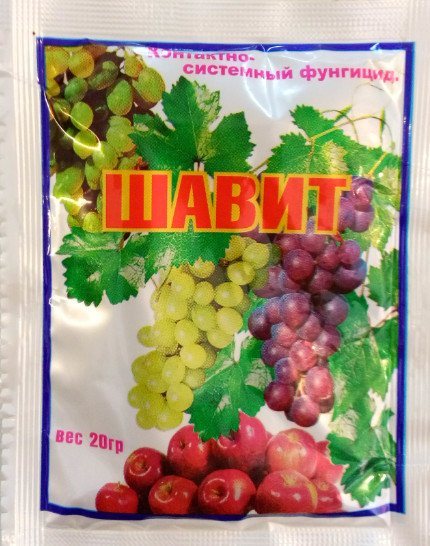

Important!
Fungicide Shavit is a very toxic drug. The maximum allowable amount of application is 2 times per season. When processing the plant, you will need to wear protective clothing.
The substance copes well with mycoses, oidium, spotting. The active ingredients are capable of providing long-term protection of the grape culture. He is able to quickly eliminate pathogenic microflora.
A brief overview of the fungicide Shavit - video
To prepare the solution, use 0.2 g. preparation in a bucket of water. Use only freshly prepared solution.
If an infection is detected, treatment is necessary 3 times per season, with breaks of 14 days.
Name of the preparation: Shavit Type: Contact Active ingredients of the fungicide "Shavit": Folpet, triadimenol Diseases and pests: Scab, late blight, gray and white rot, mildew, powdery mildew, infectious drying Degree of toxicity: High level
The drug "Falcon"
Consists of 3 components that reinforce each other,
thanks to which they perfectly fight against fungus, even in very low temperature conditions. This drug is also used for processing on a large scale.
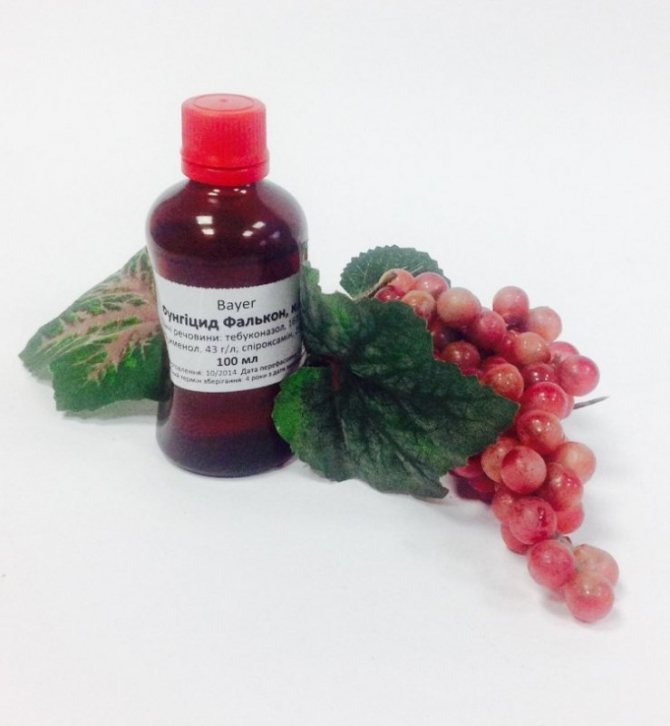

A solution with a volume of 10 liters will require only 5 ml of the drug - for prevention purposes. For treatment, a double dose is used.
Features:
- Throughout the growing season, the possibility and risk of pathogenic organisms affecting the grape culture varies. Acts on a fairly long list of infectious agents, fungi. Applied at any stage in the development of grape culture.
- It is recommended to treat it with a fungicide in the morning, since the low temperature is not an obstacle to its action.
Fungicide Falcon - video
Name of the drug: Falcon Species: Systemic Active ingredients: Spiroxamine, tebuconazole, triadimenol Diseases and pests: Septoria, rust, powdery mildew Degree of toxicity: Medium
Fungicide for the treatment of grapes "Topaz"
Topaz is a systemic fungicide used to treat various crops,
including, for the treatment of trees, bushes from fungal infection. Joint use with complex preparations is permissible. This only increases its protective properties.
Topaz is especially advised to use in the initial stage of infection of grape plants.
The active substance fights well against mildew and mildew.
Characteristics of the fungicide "Topaz" - video
To prepare a therapeutic solution, 2 ml of the substance is used per 10 liters of water. Spraying is carried out based on the type of lesion. The substance "works" for a period of 14 to 21 days. When the disease is in the acute stage, spray it after a week.
Important!
The substance is used only in the flowering stage.
Name of the drug: Topaz Type: Systemic Active ingredients of the Topaz drug: Penconazole Diseases and pests: Rust, powdery mildew, American powdery mildew, powdery mildew, spotting, gray rot, ash Degree of toxicity: Non-toxic

